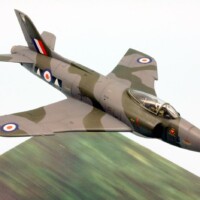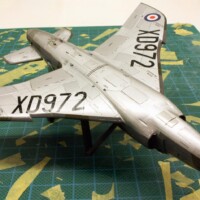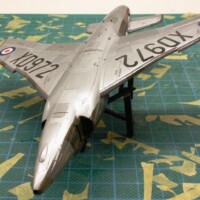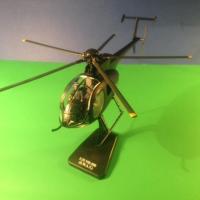A swift idea: rather than on three wheels, in their element! Supermarine Swift FR. 5, No 2 Squadron RAF Germany
About the Supermarine Swift
When the name Supermarine Swift is mentioned, even many a friend of aviation will find it difficult to associate the aircraft with it: unlike the name of the British manufacturer, which still has a good ring to it, the memory of the Supermarine Swift has faded considerably. Worse still: even if someone can actually relate to the name, it is predominantly negative associations that are invoked. For example, the Swift is seen as the little and unsuccessful brother of the brilliant Hawker Hunter, one of the most famous British-built fighter aircraft. In addition, the Swift has a nasty reputation for a disproportionately high accident rate. Its service time in the active units of the Royal Air Force was indeed short.
Yet everything had begun quite promisingly at the end of the 1940s. When, after the end of the war, the call for tenders was issued for a powerful new jet-powered fighter and fighter-bomber to replace the Gloster Meteor, two old competitors, Supermarine and Hawker, entered the ring. Supermarine started to equip a Supermarine Attacker with swept wings under the project designation "Type 510", while Hawker started the project P.1067, from which the Hunter was to emerge.
Powered by a Rolls-Royce Nene 2 engine - and incidentally, like the Attacker, still fitted with a tailwheel - the prototype VV106 successfully completed its maiden flight on 29 December 1948. The second prototype, VV119, which followed in 1950, looked much more like the final Swift: the "taildragger" had become an aircraft with a nose wheel, a built-in afterburner and devices for the installation of cannon armament already indicated its use as a fighter aircraft. Interestingly, the following flight tests also included take-offs and landings on HMS Illustrious; thus the design, already christened "Swift" at the time, has the honour of being the first carrier landing of an aircraft with arrow wings.
Supermarine's design team, led by chief designer Joseph Smith, could be satisfied; a successful design seemed to be in the offing!
The Korean War provided an enormous boost to the development and entry into service of the two promising new fighter designs at both Supermarine and Hawker. The first pre-production Swift flew on 1 August 1952, followed by a production order for 100 of the first series. These Swift F.1s were now powered by a Rolls-Royce Avon turbine, which developed 50 per cent more thrust than the original Nene engine and took the aircraft to the limit of the speed of sound. In February 1953, a Swift F.1 then broke the sound barrier for the first time as planned and without difficulty. The name of the new aircraft seemed so well chosen: "swift" in English means, among other things, "nimble" or "fast"...
The Swift was also unusually quick and nimble when it entered service. Without the usual operational testing for the introduction of a new type, the Royal Air Force began shortly afterwards to distribute the first examples of the new jet to its operational units: as early as February 1954, No 56 Squadron in Waterbeach converted to the new type. This hasty introduction of a type that was in reality not yet fully developed was to cost those responsible dearly, however, and gave the Swift its bad reputation that still lingers today.
One reason for this were untested modifications: at the request of the RAF, for example, the armament had been increased from two to four 30mm Aden machine guns, which also influenced the wing geometry: to accommodate the ammunition of the additional two MKs, the wing leading edges were pulled forward on the fuselage. This led to a sudden dramatic rearing of the aircraft at high g-loads in speed ranges above 0.85 Mach. This dangerous peculiarity was only brought under control with the installation of a sawtooth-shaped leading edge and boundary layer fences. In connection with this, it had become necessary to shift the centre of gravity towards the nose, whereby the additional ballast weight further reduced the performance of the Swift, which had become heavier anyway.
As if this bad news were not enough, it soon turned out that the afterburner installed from version F.3 onwards could only be used up to an altitude of 6,000 metres; the value of the Swift as a fighter thus dropped considerably. The following modifications, which lasted through the F.3 and F.4 variants, were not to bring any real improvement. As a fighter, the Swift, although fast as sound, was soon clearly eclipsed by the Hawker Hunter. The RAF now relied heavily on the Hunter, and no further orders were placed for the Swift. Its career as a fighter had lasted just one year.
In one niche, however, the Supermarine was able to show its true strengths: it proved to be excellently suited for low-level flight and could reach 1110 Km/h near the ground with the afterburner switched on! The RAF therefore equipped the Swift with three Vinten F95 cameras installed in an extended nose, giving it a formidable reconnaissance platform. In May 1955, the first flight of the pure reconnaissance version, designated F.5, took place, and the RAF equipped two squadrons with it, No.2 and No 79, which were deployed with the Royal Air Force Germany in Geilenkirchen and Gütersloh respectively. The two units were to fly the Swift for the next five years before the age of the Hawker Hunter began here as well.
The model experienced a brief aftermath with the planned F.7 version, which, equipped with on-board radar and the "Fireflash" air-to-air missile, was to bring the Swift back into the business of fighter flying. However, the few F.7s built were only used for testing, and this last version of the Swift was not to see regular service. The Royal Air Force now relied entirely on the Hunter. 160 Swifts were built during the short period of its use. If one compares this with the number of around 2,000 Hawker Hunters produced, it becomes clear to what extent the competitor outperformed the agile Swift.
My model shows a Supermarine Swift F.5 reconnaissance aircraft of the No 2(AC) Squadron of the Royal Air Force Germany from 1956. This unit is one of the oldest and most traditional squadrons of the RAF. Formed in 1912, it quickly specialised in the tasks of "Army Co-operation", which is also indicated by the addition (AC) in the squadron designation. The aircraft types used by the "Shiny Two" also bear eloquent witness to this specialisation: while in the First World War B.E.2 and in the interwar period Amstrong Whitworth Atlas dominated the aircraft inventory, in the years of the Second World War classic patterns of cooperation with the Army were to be found: No 2 went into combat with Westland Lysander and later the NA Mustang I. The era of the Supermarine Swift F.5 began in 1955, but it ended after only six years when it was withdrawn from service in favour of a successor model that was considered more suitable: the Hawker Hunter. Today, No 2 (AC) flies the Eurofighter Typhoon FGR4.
On the kit and the building process
Every now and then, the aesthetic refinement and beauty of form of the original seem to be wonderfully in harmony with a similarly subtle expression of the kit parts. This is clearly the case with the box contents of Airfix' Swift!
In view of the quickly revealed quality of the parts as well as their manageable number, I wanted to take my time in particular to get the best out of them at my leisure. With the consistently excellent fitting accuracy and the well thought-out parts construction, the building itself went quickly from hand. The only thing that took time was my decision to sand down the entire surface to soften the too deep panel lines.
Originally I had intended to show the Swift standing on its wheels. But the more the sleek shapes became apparent, the clearer the decision became to depict her in her actual element with retracted landing gear and smooth surfaces. The necessary pilot is from PJ Production, he sits on a fully detailed resin ejector seat with harnesses as originally planned.
I only replaced the pitot tube on the right wing, this was made from a suitable metal part from the scrap box. For the underside, which was left in NMF, aluminium tones from the Alclad range were used, the colours of the upper sides I designed with acrylic colours from Gunze.
The word "swift" is used to describe the swift and agile flying swallow-like bird, but it also stands for speed and agility. My illustration would like to come close to this and show the sleek lines of the Supermarine Swift in rapid flight. After this pleasant experience, I can enthusiastically recommend the Airfix kit without any reservations!
























Your usual excellent in every respect model, Roland, now to the form of a Swift! What a fantastic model!
Your article is equally great, so many things I learned about the Swift! In fact, after reading your article, the idea that the Swift was not that bad of a plane as often regarded (indeed, it was quite good, taking into account the period it was introduced) came into my mind. Its main "drawback" might have been that the superlative Hunter was also present!
Your words are motivating and apt! To recognize the biggest disadvantage of the Swift quite simply in the existence of the Hunter, I like. Thank you my friend 🙂
A very nice build, the gears retracted emphasises the Swift's beautiful shape. I hope Airfix brings out more decal variants and also a 1/48 version soon.
Thank you! Your wish for a 48 version I join!
Nice work, Roland. I’ve always liked the Swift’s looks.
An excellent build, Roland @rosachsenhofer
To be honest, I was not aware of this aircraft, but its shape is really beautiful, which is clearly shown with your build.
Well done.
Thank you for your kind words, John!
That Airfix kit is really nice, and you have definitely gotten the most from it. I wish they would upscale this to 1/48.
Thank you Tom, I am honored
The Airfix kit is another charmer. Its 1st pressing was reported to have issues with some of the molds push pins leaving marks in some parts. Distorted pieces with possible holes in things. It was also one of the releases that made it to the states early enough for we Yanks not to have to wait a year for the kit to hit the shores. I got a kit with out issues.
I really like your efforts in showing off this kit Roland. Especially, the photos of the underside of the kit on the bench and in the air. Most folks don't bother with this side of the kit. When it comes to photo's. Given your gifts and talents and your mention of the aircrafts after burner being used at lower altitudes, a photo of the after burner being lit up would really add to the article. I don't have the technical acumen to do that sort of graphics but, if one where to do so I think would be icing on the cake.
Overall another well written article, on a kit that has been well photographed and built up.
Two thumbs up.
Stephen, indeed a charming, not to say "burning" idea! Thank you for your inspiring words!
I remember I had a Dinky Toys Swift when I was a youngster, many years ago, and I admired its sleek lines even then, and now your Airfix model brings back those memories. Another perfect article from you, thanks for sharing it with us.
Thank you George! interesting how different the approaches to the "Swift" are!
Nicely done Roland.
Thank you!
Very cool bird I had never heard of like so many others. Love the presentation of the build and the background story.
Your words please me, thank you!
Very nice! I love the "aerial" photography. A beautiful model.
Thank you Greg, very appreciated!